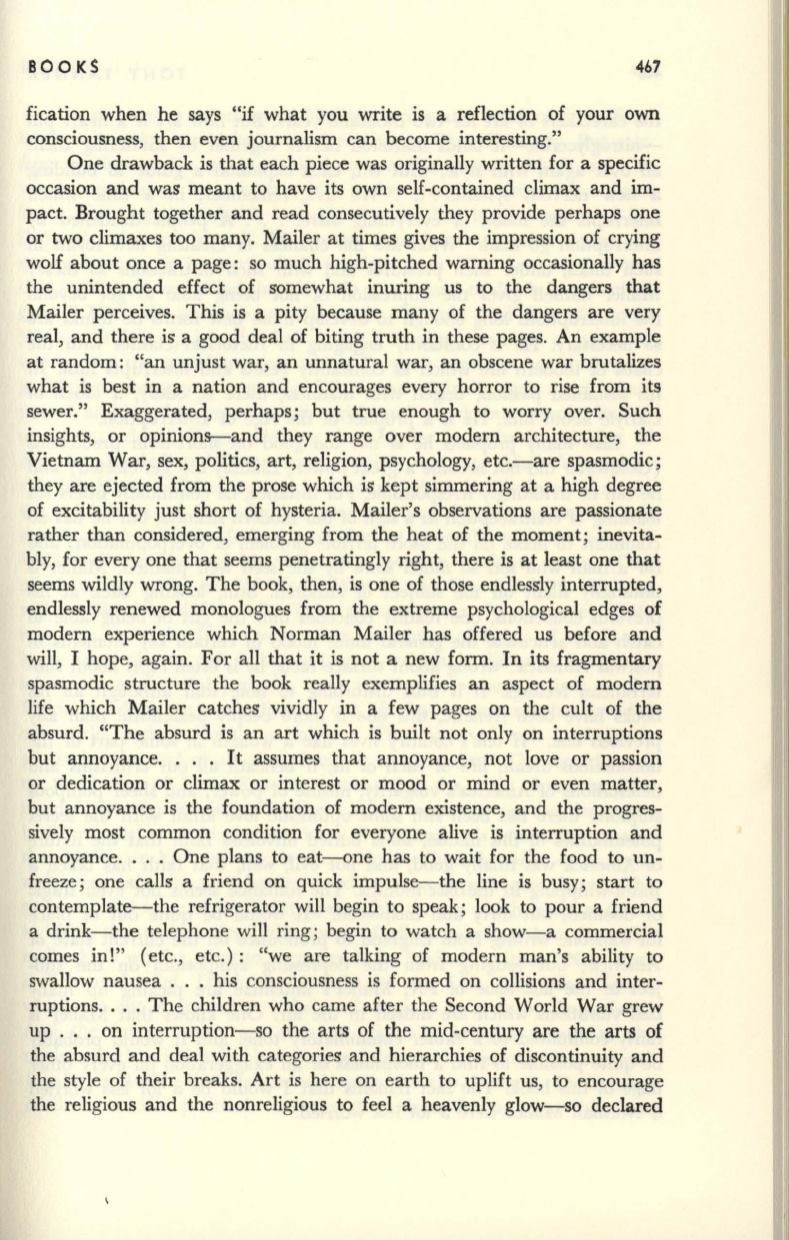
BOO KS
467
fication when he says "if what you write is a reflection of your own
consciousness, then even journalism can become interesting."
One drawback is that each piece was originally written for a specific
occasion and was meant to have its own self-contained climax and im–
pact. Brought together and read consecutively they provide perhaps one
or two climaxes too many. Mailer at times gives the impression of crying
wolf about once a page: so much high-pitched warning occasionally has
the unintended effect of somewhat inuring us to the dangers that
Mailer perceives. This is a pity because many of the dangers are very
real, and there is a good deal of biting truth in these pages. An example
at random: "an unjust war, an unnatural war, an obscene war brutalizes
what is best in a nation and encourages every horror to rise from its
sewer." Exaggerated, perhaps; but true enough to worry over. Such
insights, or opinions---and they range over modern architecture, the
Vietnam War, sex, politics, art, religion, psychology, etc.-are spasmodic;
they are ejected from the prose which is kept simmering at a high degree
of excitability just short of hysteria. Mailer's observations are passionate
rather than considered, emerging from the heat of the moment; inevita–
bly, for everyone that seems penetratingly right, there is at least one that
seems wildly wrong. The book, then, is one of those endlessly interrupted,
endlessly renewed monologues from the extreme psychological edges of
modern experience which Norman Mailer has offered us before and
will, I hope, again. For all that it is not a new form. In its fragmentary
spasmodic structure the book really exemplifies an aspect of modern
life which Mailer catches vividly in a few pages on the cult of the
absurd. "The absurd is an art which is built not only on interruptions
but annoyance.... It assumes that annoyance, not love or passion
or dedication or climax or interest or mood or mind or even matter,
but annoyance is the foundation of modern existence, and the progres–
sively most common condition for everyone alive is interruption and
annoyance.... One plans to eat-one has to wait for the food to un–
freeze; one calls a friend on quick impulse- the line is busy; start to
contemplate-the refrigerator will begin to speak; look to pour a friend
a drink-the telephone will ring; begin to watch a show-a commercial
comes in! " (etc., etc.): "we are talking of modern man's ability to
swallow nausea . . . his consciousness is formed on collisions and inter–
ruptions.... The children who came after the Second World War grew
up ... on interruption- so the arts of the mid-century are the arts of
the absurd and deal with categories and hierarchies of discontinuity and
the style of their breaks. Art is here on earth to uplift us, to encourage
the religious and the nonreligious to feel a heavenly glow-so declared


